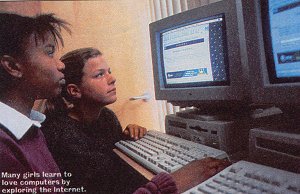
When it comes to computers and technology...
Are Girls Being Shortchanged?
From: Parade, February 8th, 1998
GIRLS WILL LIKE:
ALL KIDS WILL LIKE:
Good software doesn't have to have a "Girlish" theme. Warren Buckleitner, editor of
Children's Software Revue, which tests software (www.childrenssoftware.com), selected
these titles that let both girls and boys go on adventures, make things, explore and learn.
By Sara Brzowsky
Great Software
For Girls (And Boys)

UP UNTIL RECENTLY, parents who ventured into a computer-software store looking for something to interest a preteen daughter usually came away empty-handed. There were shelves of games aimed at boys - mostly shoot-em-ups full of guns and gore - but there was nothing very appealing for the adolescent or teenage girl who just wanted to have fun on the computer.
Does it matter? If a girl doesn't want to play on the computer, why should she be pushed to do so? Experts and educators say it does matter. Research shows that playing with computer games helps develop an array of learning skills, such as focusing, concentration and problem solving. Most important, perhaps, it helps children to acquire a familiarity and ease with technology - of critical importance in the future job market. The occupations with the fastest employment growth for the next decade, according to a 1997 Bureau of Labor Statistics report, are computer scientists, computer engineers and systems analysts.
"Computers are not for girls." "Absolutely untrue," says Roberta Furger, author of the book Does Jane Compute? Preserving Our Daughters' Place in the CyberRevolution. "Given the opportunity - and that's key - girls demonstrate an interest in computers time and again."
As young children, girls play on the computer as much as boys do, studies show - and, significantly, software available at this stage is the same for both groups. Then, as boys and girls grow and develop different interests, the software available for girls dries up.
| How Adults Can Help
(From Roberta Furger and GirlTECH) FOR A YOUNG GIRL, purchase games that appeal to her. The more time she spends on the computer, the more confident she'll be with it. AT HOME, put the computer in a central location, such as a family room, and give girls equal access with their brothers.
|
Brenda Laurel, co-founder of Purple Moon, a software company for girls, headed a research team that studied boys' and girls' play. "The main objection of girls to existing computer games," she says, "was that they are boring. Girls tend to be interested in character and story and social complexity in their play. They're not drawn to speed and action, or defeating opponents, or high scores for their own sake, or beating the clock."
At school. Differing expectations of girls and boys often are perpetuated in school. Cynthia Lanius, a math teacher at Milby High School in Houston, recalls the first time she introduced a class to the Internet: "I took a laptop into class, hooked it up and said, 'how many of you would like to see the Internet?' Nine students rushed to my desk - eight boys and one girl. I thought, 'Boy. is this an in-my-face symbol of the problem!'" She notes that teachers often allow boys to dominate computer classes. The less assertive girls, left by the wayside, often don't increase their skills much.
A similar problem has existed regarding the teaching of math and science to girls. "Technology requires far more attention," says Janice Weinman, executive director of the American Association of University Women, which conducted a landmark study of the issue. "There seems to be much more encouragement for boys to go into the advanced areas, whereas girls have sometimes felt out of place in these areas."
Opening doors online. One thing girls do like is Internet chat rooms. "They provide the opportunity for relationships - extremely important to adolescent girls," notes Roberta Furger. And for many girls, chat rooms become the gateway to more challenging online exploration. "They are applying the technology to the kinds of interests they have off the computer. They form clubs. It's not competitive, it's a community."
Made for girls. In 1996, Mattel Media introduced Barbie Fashion Designer - a CD-ROM that let girls design and print out clothes for Barbie and every little girl wanted one. It became a No. 1 seller, opening the door for other innovative companies (many founded by women) to create games and activities for girls. While still only a tiny share of the market, they are at last offering girls some choices.
For more information about encouraging girls' interest in computers, visit the GirlTECH
site at http://math.rice.edu/~lanius/club/girls.html on the Web.
Sites &
Affiliations | Leadership | Research & Applications | Major
Accomplishments | FAQ | Search | Knowledge &
Technology Transfer | Calendar of
Events | Education
& Outreach | Media
Resources | Technical Reports &
Publications | Parallel Computing Research Quarterly Newsletter | News Archives | Contact
Information
Hipersoft | CRPC